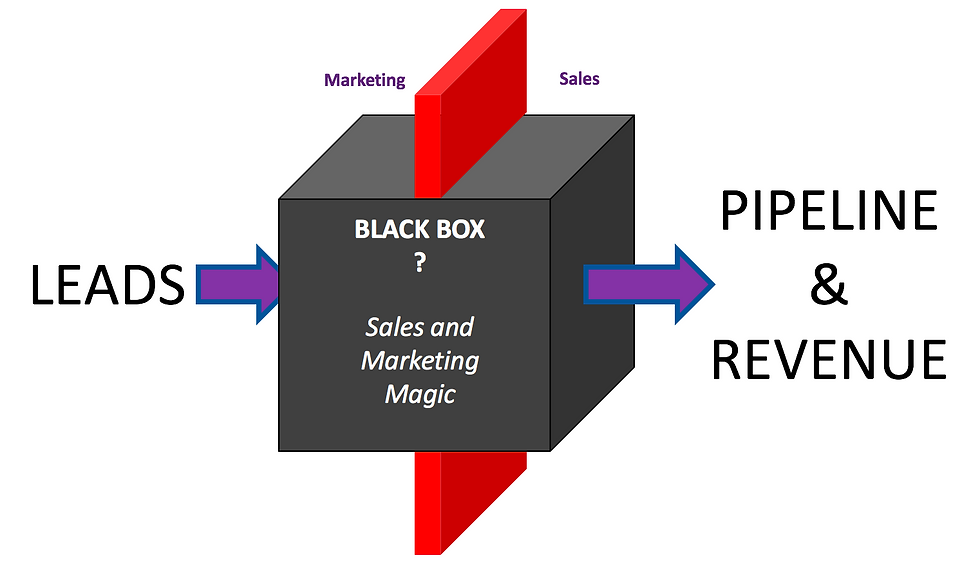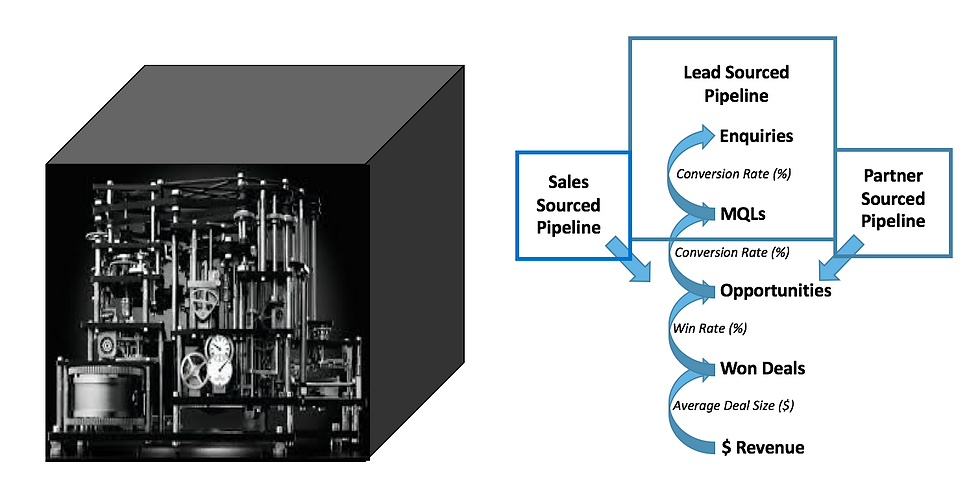
This is the Sandhan Valley (Maharashtra’s Grand Canyon), near Mumbai, India. During the monsoon, this waterfall comes to life and is known for a bizarre phenomenon – it flows in reverse! Well, OK not really, but it's kinda cool and it provides me a great way to ease you into this post ;-)
You know your own revenue waterfall pretty well, I am assuming. Leads flow into the top, convert through whatever pre-MQL stages you have defined as part of your nurture programs (and maybe into a team of BDRs or SDRs), sales-ready leads/appointments are created that generate opportunities and convert at a certain value to 'closed won' deals. All relatively simple, but how many of you reverse engineer it, in order to establish marketing's strategic accountability and set KPIs that are relevant to your peers?
"Where are All My Leads?"
Before we talk in more detail about Reverse Waterfall Planning (RWP) itself, let me ask another (somewhat leading) question.....Hands up if, when the team (note that I didn't just say sales....it's 'the team') is at risk of missing it's number, you've heard the statement "I don't have enough leads!"?
Wow, every hand on the blog just went up!
The reason that we have all been in the middle of the "where are all my leads?" debate is because, despite marketing becoming increasingly data-driven, few companies have the management processes and the planning and measurement frameworks to lay out a model for how revenue is generated. By this I mean, what is sales responsible for generating, what is channel responsible for, and what is marketing going to bring to the table? [If anyone at this stage is saying "well, isn't marketing responsible for sourcing it all?", then it might be best if you leave now! Influencing, maybe, but sourcing.....nope]
The "where are my leads" issue is a basic function of the fact that most companies look at their waterfall as a black-box.....an input-output machine that they review retrospectively, and that creates a hard line between sales and marketing, where the lead is a firm "hand-off" between the two.

The conversation at the end of the month or quarter goes something like this; "did we hit our number? No. Why? Well, it must be because the inputs (leads from marketing) into the process were insufficient, right?"
This approach makes a bunch of oversimplifications, not least of which, the interactions between sales and marketing within that "black box" are increasingly messy and non-linear, but also:
Assuming we have a volume issue, where is that volume supposed to be coming from? Sales, marketing or channel?
Is it a pure top-of-funnel volume issue or is there too much friction in the lead and pipeline development process? Are things not converting into downstream volume?
Is it really a value issue? Are we actually generating enough leads, but they are not closing at the right average deal size.
More on all this later! I am getting ahead of myself....
Reverse Waterfall Planning (RWP)
Reverse Waterfall Planning (RWP) is an extremely valuable tool that forms the basis of every marketing plan I have ever developed. In simple terms, it starts with revenue (which, you all agree (although many forget!) is marketing's number one KPI) and backs out all of the elements of the waterfall above, to determine how many leads, MQLs, appointments, opportunities and closed won deals are needed, at what rate they are expected to convert and at what deal value, to generate the revenue that the business needs - preferably for each sales team that you support.
We are basically cracking open that black box to look at the inner workings of the machine, so that we can a) better diagnose problems, and b) know which levers to pull in order to make changes in a timeframe that matters.

The result is a set of KPIs for each element of the waterfall that can act as benchmarks for future performance, so that, at any time we can say "Did we make our number, and if not, why not?".
Now all of this can get very complicated very quickly, which is why a solid methodology and some templates come in handy, but there are tips and tricks to keep things simple. At least, at the start. For example, you can just start with an overall model for the company, rather than breaking it down by region or sales team. Or, you can simplify the steps in the waterfall to keep the universe of assumptions more limited and then expand later.
Choosing Useful Benchmarks
One of the hardest things is knowing how to set the benchmarks. Do I simply use historical data, or do I need to set stretch goals? There's no simple answer to this, but the simplest one, to some extent is that it doesn't matter. At the end of the day, it is how you use the tool that is important, not necessarily whether you got the assumptions right in the first place.
If you're doing RWP to use it as stick to beat people over the head when they don't perform then you'd better be damn sure about the validity and achievability of your assumptions. But if you are using it as a planning tool, to bring key stakeholders to the table in order to better understand how all the various components work together to drive revenue, and where to focus cross-team improvements, then, just make your best educated guess. And, in meetings the key discussion points should be..."were our assumptions right? If so, we have a performance issue in that area. If not, then let's better improve our benchmarking".
But the key is, that for the first time, you'll have a tool that allows marketing, sales and channel to come to the table and have constructive and transparent conversations during planning and review that lead to actionable, tactical improvements....either in modeling the business or executing it!
Marketing Accountability
The key here is that just because marketing may be generating the leads that an RWP model predicts, it is absolutely not an excuse to devolve itself of responsibility for everything else! There are two (unqualified) statements that people who know me, know that I have zero tolerance for:
From sales: "I don't have enough leads"
From marketing: "I've given you enough leads, everything else is your problem"
In response to the latter.... the simple answer is "far from it"! All of this is actually a way for marketing to justify all the other things that we desperately want to invest in (but don't have time because we are constantly chasing leads), not to avoid responsibility for them!
Volume vs Value (the 'tie-in' to Balanced Demand Generation)
This one strikes right at the heart of my other favorite topic......ABM vs. Transactional demand generation. If we simply view the waterfall as an input-output machine, marketing will always be in the vortex of generating more leads and won't have time to come up for air and take stock of what really needs to be done.
What does this have to do with ABM I hear you ask? Consider the situation where marketing generates 100 leads a week, 30% of which convert to opportunities, and 30% of those convert to deals with an average deal size of $100,000. That's $900k in closed revenue. But the sales target was $1.1m.....we missed by almost 20%! Why? Well, surely it's because we didn't have enough leads, right?! If we had had 119 leads instead of 100, we would have hit our number!" Well, in this case, that's not the case. The actual reverse waterfall model that we are benchmarking against in this example...it had a target of 100 leads (check), 30 opportunities (check) and 9 wins (check)...so what went wrong? Average deal size went wrong....we closed every deal at $100k when the KPI was $122k. So, we could chase our tail and drive more leads, or we could focus on initiatives that increase average deal size. But, the other mistake that is often made here is that to get the average deal size up by 22%, we have to get every deal size up by 22%. Nope! And this is where ABM comes in. A better way is to focus on those accounts that can sustain higher transaction values, and increase deal sizes in those high potential, target accounts! So, marketing doesn't walk away from the issue, it simply redeploys resources to ABM initiatives with sales, rather than chasing diminishing returns in driving more leads.
[If I could visualize a mic drop here, I would]. Boom!
Sourcing vs Influence
In a world of attribution modeling, there is an ongoing discussion about sourcing and influence. Marketing has two responsibilities, sourcing leads and influencing leads that are sourced elsewhere. And those responsibilities differ depending on the nature of the go-to-market motion, because not all go-to-market motions are created equal. Marketing may be accountable for sourcing a relatively large portion of revenue for a high-volume, high-velocity team like inside sales, but a smaller portion of the pipeline for a strategic accounts/field sales team. But, again that doesn't mean that marketing puts it's feet up and doesn't support the latter. It means that it influences the opportunities that are sourced by sales and channel - RWP here acts as a way of justifying increased investments in partner marketing, sales enablement and/or ABM!
More on all this another time.
Some Conclusions
OK, I guess it's time to wrap this one up for now.....
Reverse Waterfall Planning is a very powerful tool if used correctly. Here are some key takeaways:
Use it to bring key stakeholders together as a way of benchmarking how revenue is actually generated in your business and what parts of the waterfall need improving;
Use the results on a regular cadence to improve, not to judge!
Start simple and expand as folks get more comfortable with how it will be used
Don't let marketing off the hook if the conclusion is that lead flow is good!
Sit back and watch sales and marketing work in perfect harmony! (just kidding! ;-))






